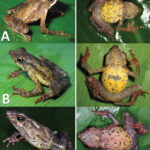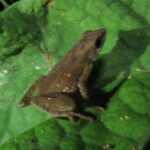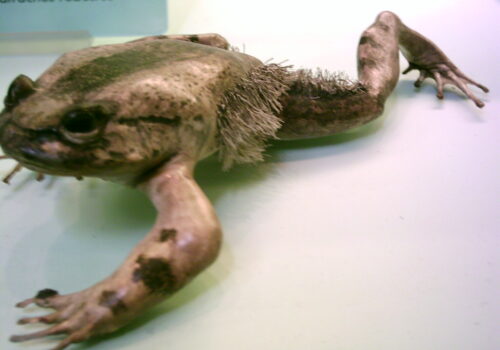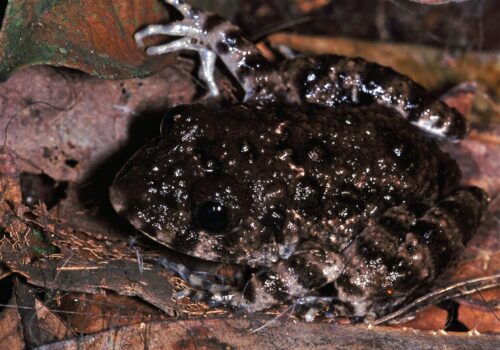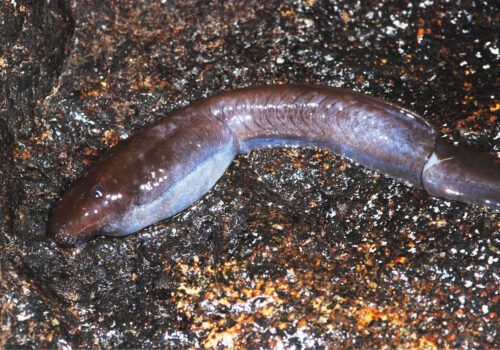- Leptopelis marginatus: Discovering the Enigmatic Forest Guardian of West Africa
Leptopelis marginatus: Discovering the Enigmatic Forest Guardian of West Africa#
Hidden amidst the dense foliage of West Africa’s lush rainforests, lives a gentle yet elusive amphibian whose subtle beauty belies its ecological importance—Leptopelis marginatus, commonly known as the Margined Forest Tree Frog. Quietly perched among emerald leaves or concealed within moist crevices, this fascinating creature remains largely unknown to most, yet deeply intertwined with the health of the vibrant ecosystems it inhabits.
In the stillness of humid forest nights, soft yet melodious calls echo gently through tangled vegetation. Such chorus is the nocturnal symphony produced by Leptopelis marginatus—a vital voice maintaining balance within delicate tropical ecosystems. Beyond its lyrical contribution, this species serves as both predator and prey, signaling through its presence the overall health and continuity of West African forests. Let’s embark on an immersive exploration into the world of this charming amphibian, uncovering the richness of its life and the challenges faced in its fragile habitat.
Taxonomy and Classification#
Leptopelis marginatus is an amphibian species belonging to the family Arthroleptidae, commonly populated by terrestrial and arboreal frogs with unique ecological roles. It is classified within the vibrant genus Leptopelis, a diverse group of tree frogs renowned for their arboreal adaptations and captivating vocalizations. The genus name “Leptopelis” derives from the Greek phrase “thin skin,” reflecting the delicate texture of these frogs, a characteristic that aids their respiration in moist environments.
The species name “marginatus” translates roughly to “bordered,” a direct reference to the distinctive markings that frame its gentle greenish-brown coloration. Within its genus, Leptopelis marginatus shares closest kinship with other West African Leptopelis frogs, all of whom possess adaptations finely tuned to rainforest life. Understanding its specific place in taxonomy helps conservationists ascertain biological needs, behaviors, and evolutionary resilience of this enchanting tree frog.
Natural Habitat#
A Realm Beneath Forest Canopies#
Although rarely observed due to its secretive nature, Leptopelis marginatus thrives primarily within the tropical moist lowland forests and subtropical moist montane forests stretching over countries such as Ivory Coast, Ghana, Guinea, Liberia, and Sierra Leone. Preferring elevations that vary from sea level up to around 1,000 meters, these amphibians have perfected the art of blending seamlessly into vibrant foliage, moss-covered trees, and densely planted stream edges.
True to its arboreal essence, this tree-dwelling frog spends much of its time perched on leaves or limbs among the midstory layers of the forest canopy. Here, it relies on a combination of abundant moisture and shaded micro-habitats afforded by prolific vegetation growth. They are particularly associated with pristine habitats composed of towering hardwood trees, ever-present leaf-litter, clear-flowing streams, and occasional swampy marshes—ecological traits essential for egg-laying and tadpole survival.
An Intricate Dance with Nature#
The persistence of Leptopelis marginatus within this rich, humid environment hinges greatly upon the delicate balance between forest health and amphibian biology. Its thin, porous skin dependently absorbs moisture directly from its surroundings, linking the frog’s survival directly to humidity levels sustained by natural canopy cover. Consequently, when ancient trees fall to logging or habitat fragmentation reduces water retentiveness, the very existence of this sensitive frog hangs in the balance, revealing intimate dependencies within these forests’ microclimates.
Physical Characteristics#
Leptopelis marginatus embodies stunning physical adaptations ideally suited for rainforest life. Typically measuring between 35 to 55 millimeters in body length, the frog presents gracefully compact proportions elegantly designed for arboreal navigation. Its powerful and adhesive toe pads provide excellent climbing agility, affording this nimble creature easy ascents and descents amid tangled branches and slippery leaves.
Coloration remains its most striking beauty, dressed neatly in shades of olive-green, soft brown, or grayish hues that shade gently into vibrant yellow or creamy white undersides. Most tellingly, outlining patterns frame the margins of its limbs—dark stripes juxtaposed against lighter backgrounds lend the frog its descriptive common and scientific names. Such meticulous coloration provides effective camouflage against tree bark, foliage, and lichens, enabling the frog to remain discreetly unseen by potential predators and prey alike.
Adding to this visual spectacle, large, expressive eyes crowned with golden iris hues offer not only aesthetic charm but also acute vision under low-light forest conditions—an essential adaptation for successful nocturnal hunting. Upon closer inspection, observers note the distinctive slender physique and velvety skin texture, designed perfectly for effective moisture absorption amidst moist forest air.
Behavior and Life Cycle#
A Symphony Under Moonlit Leaves#
As twilight yields to nightfall, the forest resonates gently with rhythmic melodies carried sweetly through the dense night air. Male Leptopelis marginatus frogs, signaling territory or courting potential mates, initiate a chorus characterized by subtle trill-like calls, varying from quiet melodious chirps near streams to vibrant choruses in the canopy. Utilizing their vocal sacs tucked discreetly beneath the throat, male frogs amplify these melodic calls precisely tuned to resonate clearly through thick vegetation.
Nurturing the Future Generations#
Breeding coincides with seasonal rainfall when conditions become optimally moist and hospitable for developing frog eggs and larvae. Upon successful mating, female frogs deposit gelatinous egg clusters strategically attached to leaves and stems overhanging still-water pools or slow-flowing streams. In an elegant evolutionary strategy, as rainwater gently bathes these clusters and gravity intervenes, hatching tadpoles smoothly transition from terrestrial leaves into aquatic realms below.
Tadpoles of Leptopelis marginatus showcase impressive aquatic adaptations. Sporting muscular tails, they navigate underwater habitats adeptly, feeding primarily on algae or microscopic organic matter suited to their growth stages. Gradually metamorphosing into juveniles over several weeks or months depending on environmental conditions, they emerge as delicate miniature versions of their parents, quickly adopting arboreal lifestyles and gradually ascending to higher vegetation levels, thus perpetuating intricate cycles reflective of their species’ successful evolutionary strategy.
Ecological Role#
Amphibians such as Leptopelis marginatus play intricate ecological voicing clear indicators of environmental quality. As predators, they maintain insect populations, actively hunting mosquitoes, termites, beetles, and moths. Their activity moderates the delicate ecological balance as they themselves lend sustenance to larger predators such as birds, reptiles, and small mammals, becoming an integral thread within the complex forest food web.
Moreover, the species’ habitat sensitivity serves as a valuable ecological barometer—its presence or subtle decline signaling to conservationists and researchers critical changes in pristine rainforest ecosystems. These amphibians act as sentinel species, whose health provides early warnings of habitat degradation and environmental pollution, contributing vital insight for informed conservation actions.
Threats and Conservation Status#
The Harsh Reality of Habitat Loss#
Increasingly, the Leptopelis marginatus faces grim threats primarily driven by rapid deforestation, expanding agriculture, logging operations, and indiscriminate land clearing within its native range. Forest fragmentation disrupts crucial humidity and moisture balance, exposing fragile amphibian communities to increased vulnerability.
Added to these pressures, climate change alters rainfall patterns critical for breeding cycles, and pollution of streams compromises tadpole development—factors converging into accelerating population declines. Currently listed as “Near Threatened” by the IUCN Red List, this subtle yet significant threat underscores urgent calls for proactive conservation efforts, habitat protections, and sustainable forestry practices.
Cultural and Scientific Significance#
Although relatively unknown culturally compared to charismatic megafauna, Leptopelis marginatus symbolizes biological richness and intricate complexity of West Africa’s biodiversity hotspots. From a scientific perspective, species within genus Leptopelis have unveiled insights into evolutionary adaptations, functional morphology, and holistic forest ecosystem dynamics. Continued research into this species also aids better environmental management practices and enhances awareness around amphibian conservation urgently needed globally.
Conclusion: A Call to Protect the Margined Forest Guardian#
Leptopelis marginatus, though delicate and unassuming, encapsulates profound ecological significance and embodies exceptional adaptive traits designed exquisitely for rainforest survival. Preserving the habitats that shelter this remarkable amphibian translates directly into protecting broader biodiversity, securing ecosystem resilience, and safeguarding our shared environmental heritage.
Let us advocate passionately for the conservation of West African ecosystems, ensuring future generations may continue to hear the soft, melodic songs of our enigmatic forest guardians—the irreplaceable, exquisite Leptopelis marginatus.


